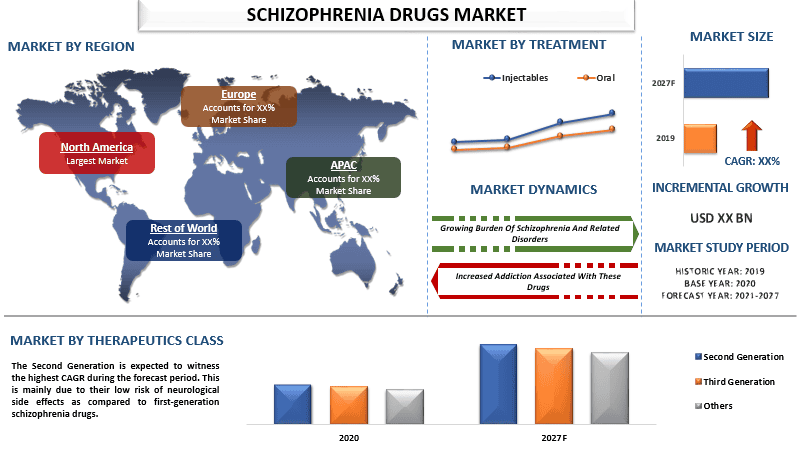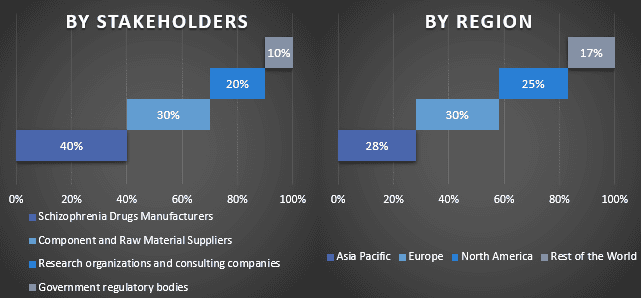Рынок препаратов для лечения шизофрении: текущий анализ и прогноз (2021-2027)
Акцент на терапевтический класс (второе поколение, третье поколение, другие); лечение (оральное, инъекции); регион/страна

Ожидается, что рынок препаратов для лечения шизофрении будет демонстрировать среднегодовой темп роста (CAGR) около 4% в течение периода 2021-2027 гг. Шизофрения – это серьезное психическое расстройство, при котором люди ненормально интерпретируют реальность. Шизофрения может вызывать галлюцинации, бред и крайне неорганизованное мышление и поведение, которые мешают повседневной деятельности и могут приводить к инвалидности. Лечение шизофрении состоит из антипсихотических препаратов и требует пожизненного лечения, даже когда симптомы стихли. Лекарства от шизофрении часто контролируют симптомы расстройства, регулируя дофамин, важнейший нейромедиатор. В последние десятилетия лечение шизофрении претерпело изменения, поскольку многие пациенты перешли с препаратов первого поколения и типичных антипсихотиков на препараты второго и третьего поколений, также известные как атипичные антипсихотики. Антипсихотики второго и третьего поколений предпочтительнее из-за серьезных побочных эффектов, связанных с препаратами первого поколения, таких как ригидность, брадикинезия, дистонии, тремор и акатизия. В связи с этим участники отрасли сосредотачиваются на выпуске новых атипичных антипсихотических препаратов 2-го и 3-го поколений на рынок для расширения своего продуктового портфеля, что, в свою очередь, приводит к увеличению числа одобрений FDA. Например, в июне 2021 года компания Alkermes plc объявила о том, что Управление по санитарному надзору за качеством пищевых продуктов и медикаментов США (FDA) одобрило LYBALVI™ (оланзапин и самидорфан) для лечения взрослых с шизофренией и для лечения взрослых с биполярным расстройством I типа. LYBALVI – это принимаемый один раз в день пероральный атипичный антипсихотик, состоящий из оланзапина, хорошо известного антипсихотического агента, и самидорфана, нового химического соединения.
Кроме того, ожидается, что рынок препаратов для лечения шизофрении будет расти благодаря увеличению распространенности шизофрении, а также растущему спросу на улучшенные лекарства и лечение. Например, согласно данным Национального института психического здоровья (NIMH) и Всемирной организации здравоохранения (ВОЗ), шизофрения, как известно, оказывает существенное бремя на пациентов, их семьи и общество. Только в США этим расстройством страдают примерно 3,5 миллиона человек, и ежегодно регистрируется около 4000 новых случаев.
- Lundbeck A/S, Otsuka Pharmaceutical Co., Ltd., Janssen Pharmaceuticals, Inc., Eli Lilly and Company, AstraZeneca, ALLERGAN, Vanda Pharmaceuticals Inc., Sumitomo Dainippon Pharma Co., Ltd., Alkermes plc, Bristol-Myers Squibb Company – вот некоторые из ключевых игроков на рынке. Эти игроки заключают многочисленные сделки по слияниям и поглощениям, а также партнерства, чтобы предоставлять клиентам новые лекарства.
Основные сведения, представленные в отчете
«Среди терапевтических классов на категорию второго поколения приходилась большая часть рынка в 2020 году»
В зависимости от терапевтического класса рынок классифицируется как второе поколение, третье поколение и другие. Среди терапевтических классов на категорию второго поколения приходилась значительная доля рынка. Это в основном связано с низким риском неврологических побочных эффектов по сравнению с препаратами для лечения шизофрении первого поколения. Одним из наиболее предпочтительных лекарств является рисперидон, также известный как антипсихотик второго поколения (SGA) или атипичный антипсихотик. Рисперидон уравновешивает дофамин и серотонин и улучшает мышление, настроение и поведение. Ожидается, что он поможет вылечить некоторые или все симптомы шизофрении.
«Ожидается, что среди методов лечения самый высокий среднегодовой темп роста (CAGR) в течение прогнозируемого периода продемонстрируют инъекции»
В зависимости от лечения рынок подразделяется на пероральный и инъекционный. Ожидается, что среди них сегмент инъекций продемонстрирует самый высокий среднегодовой темп роста (CAGR) в течение прогнозируемого периода. Инъекционные препараты для лечения шизофрении, особенно инъекции длительного действия, являются одним из самых передовых видов лечения. Инъекции длительного действия (LAI) часто помогают устранить побочные эффекты перорального лечения шизофрении. LAI также обеспечивает лучшую эффективность и переносимость благодаря улучшению приверженности и более стабильной фармакокинетике. Тем самым стимулируя рост этого сегмента.
«Ожидается, что в Северной Америке будет наблюдаться значительный рост в течение прогнозируемого периода»
Для лучшего понимания динамики рынка препаратов для лечения шизофрении был проведен подробный анализ для различных регионов по всему миру, включая Северную Америку (США, Канада и остальная часть Северной Америки), Европу (Германия, Франция, Испания, Великобритания, Италия и остальная часть Европы), Азиатско-Тихоокеанский регион (Китай, Индия, Австралия, Япония и остальная часть APAC), остальной мир. Северная Америка представляет собой основной рынок для индустрии препаратов для лечения шизофрении в 2020 году благодаря сильной инфраструктуре здравоохранения и растущему внедрению препаратов для лечения шизофрении в регионе.
Причины купить этот отчет:
- Исследование включает анализ размера рынка и прогнозирование, подтвержденные проверенными ключевыми экспертами отрасли.
- Отчет представляет собой краткий обзор общей эффективности отрасли с первого взгляда.
- Отчет охватывает углубленный анализ видных представителей отрасли с уделением особого внимания ключевым финансовым показателям бизнеса, продуктовому портфелю, стратегиям расширения и последним разработкам.
- Подробное изучение движущих сил, ограничений, ключевых тенденций и возможностей, преобладающих в отрасли.
- Исследование всесторонне охватывает рынок по различным сегментам.
- Углубленный анализ отрасли на региональном уровне.
Варианты настройки:
Глобальный рынок препаратов для лечения шизофрении может быть дополнительно настроен в соответствии с требованиями или любым другим сегментом рынка. Кроме того, UMI понимает, что у вас могут быть свои собственные бизнес-потребности, поэтому не стесняйтесь обращаться к нам, чтобы получить отчет, который полностью соответствует вашим требованиям.
Содержание
Методология исследования для анализа глобального рынка препаратов от шизофрении (2021-2027 гг.)
Анализ исторического рынка, оценка текущего рынка и прогнозирование будущего рынка глобального рынка препаратов от шизофрении были тремя основными шагами, предпринятыми для создания и анализа внедрения препаратов от шизофрении в основных регионах мира. Было проведено исчерпывающее вторичное исследование для сбора исторических данных о рынке и оценки текущего размера рынка. Во-вторых, для подтверждения этих выводов было принято во внимание множество результатов и предположений. Кроме того, были проведены исчерпывающие первичные интервью с отраслевыми экспертами по всей цепочке создания стоимости глобального рынка препаратов от шизофрении. После предположения и подтверждения рыночных показателей посредством первичных интервью мы применили подход «сверху вниз»/«снизу вверх» для прогнозирования полного размера рынка. После этого были приняты методы разбивки рынка и триангуляции данных для оценки и анализа размера рынка сегментов и подсегментов, к которым относится отрасль. Подробная методология описана ниже:
Анализ исторического размера рынка
Шаг 1: Углубленное изучение вторичных источников:
Было проведено детальное вторичное исследование для получения исторических данных о размере рынка препаратов от шизофрении из внутренних источников компании, таких как годовой отчет и финансовая отчетность, презентации результатов деятельности, пресс-релизы и т. д., и внешних источников, включая журналы, новости и статьи, правительственные публикации, публикации конкурентов, отраслевые отчеты, базы данных третьих сторон и другие надежные публикации.
Шаг 2: Сегментация рынка:
После получения исторических данных о размере рынка препаратов от шизофрении мы провели детальный вторичный анализ для сбора исторических данных о рынке и доли различных сегментов и подсегментов для основных регионов. Основные сегменты, включенные в отчет, - это терапевтический класс и лечение. Был проведен дальнейший анализ на уровне стран для оценки общего внедрения моделей тестирования в этом регионе.
Шаг 3: Факторный анализ:
После получения исторических данных о размере рынка различных сегментов и подсегментов мы провели детальный факторный анализ для оценки текущего размера рынка препаратов от шизофрении. Кроме того, мы провели факторный анализ с использованием зависимых и независимых переменных, таких как различные терапевтические классы и методы лечения шизофрении. Был проведен тщательный анализ сценариев спроса и предложения с учетом ведущих партнерств, слияний и поглощений, расширения бизнеса и запуска продуктов в секторе рынка препаратов от шизофрении по всему миру.
Оценка текущего размера рынка и прогноз
Определение текущего размера рынка: Основываясь на действенных выводах, полученных на основе вышеуказанных 3 шагов, мы определили текущий размер рынка, ключевых игроков на глобальном рынке препаратов от шизофрении и доли рынка сегментов. Все необходимые процентные доли разделения и разбивки рынка были определены с использованием вышеупомянутого вторичного подхода и были проверены посредством первичных интервью.
Оценка и прогнозирование: Для оценки и прогнозирования рынка различным факторам, включая драйверы и тенденции, ограничения и возможности, доступные для заинтересованных сторон, были присвоены веса. После анализа этих факторов были применены соответствующие методы прогнозирования, то есть подход «сверху вниз»/«снизу вверх», чтобы прийти к прогнозу рынка примерно на 2027 год для различных сегментов и подсегментов на основных рынках по всему миру. Методология исследования, принятая для оценки размера рынка, включает:
- Размер рынка отрасли с точки зрения выручки (долл. США) и темпы внедрения препаратов от шизофрении на основных рынках внутри страны
- Все процентные доли, разделения и разбивки сегментов и подсегментов рынка
- Ключевые игроки на глобальном рынке препаратов от шизофрении с точки зрения предлагаемых решений. Кроме того, стратегии роста, принятые этими игроками для конкуренции на быстрорастущем рынке
Подтверждение размера рынка и доли
Первичное исследование: Были проведены углубленные интервью с ключевыми лидерами мнений (KOL), включая руководителей высшего звена (CXO/VP, руководитель отдела продаж, руководитель отдела маркетинга, руководитель операционного отдела и региональный руководитель, руководитель страны и т. д.) в основных регионах. Затем были обобщены результаты первичных исследований и проведен статистический анализ для доказательства заявленной гипотезы. Данные первичных исследований были объединены с результатами вторичных исследований, что превратило информацию в полезные сведения.
Разбивка первичных участников по различным регионам

Инжиниринг рынка
Для завершения общей оценки рынка и получения точных статистических данных по каждому сегменту и подсегменту глобального рынка препаратов от шизофрении использовалась техника триангуляции данных. Данные были разделены на несколько сегментов и подсегментов после изучения различных параметров и тенденций в областях терапевтического класса и лечения на глобальном рынке препаратов от шизофрении.
Основная цель исследования глобального рынка препаратов от шизофрении
В исследовании были точно определены текущие и будущие тенденции рынка глобального рынка препаратов от шизофрении. Инвесторы могут получить стратегические сведения для обоснования своего усмотрения в отношении инвестиций на основе качественного и количественного анализа, проведенного в исследовании. Текущие и будущие тенденции рынка определили общую привлекательность рынка на региональном уровне, предоставляя платформу для промышленного участника для использования неиспользованного рынка, чтобы получить выгоду в качестве преимущества первопроходца. Другие количественные цели исследований включают:
- Анализ текущего и прогнозируемого размера рынка препаратов от шизофрении в стоимостном выражении (долл. США). Кроме того, проанализируйте текущий и прогнозируемый размер рынка различных сегментов и подсегментов
- Сегменты исследования включают области терапевтического класса и лечения.
- Определение и анализ нормативно-правовой базы для индустрии рынка препаратов от шизофрении.
- Анализ цепочки создания стоимости, связанной с присутствием различных посредников, а также анализ поведения клиентов и конкурентов отрасли.
- Анализ текущего и прогнозируемого размера рынка препаратов от шизофрении для основного региона.
- Основные страны регионов, изученные в отчете, включают Азиатско-Тихоокеанский регион, Европу, Северную Америку и остальной мир.
- Профили компаний рынка препаратов от шизофрении и стратегии роста, принятые участниками рынка для поддержания себя на быстрорастущем рынке
- Углубленный анализ отрасли на региональном уровне
Связанные Отчеты
Клиенты, купившие этот товар, также купили










